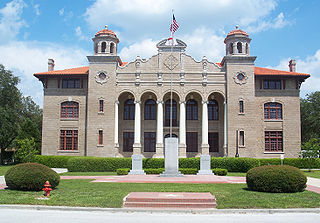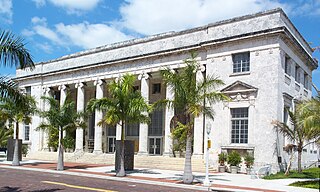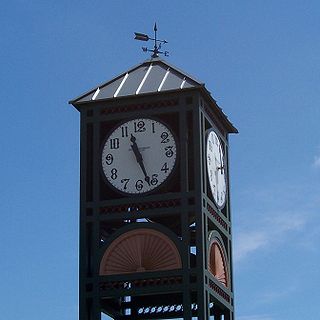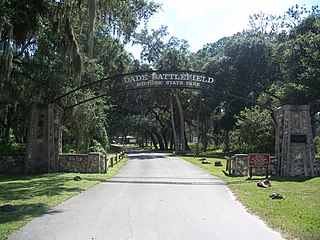
Alachua County is a county in the north central portion of the U.S. state of Florida. As of the 2020 census, the population was 278,468. The county seat is Gainesville, the home of the University of Florida since 1906, when the campus opened with 106 students.

Hernando County is a county located on the west central coast of the U.S. state of Florida. As of the 2020 census, the population was 194,515. Its county seat is Brooksville, and its largest community is Spring Hill.

Lake County is a county in the central portion of the U.S. state of Florida. As of the 2020 census, the population was 383,956. Its county seat is Tavares, and its largest city is Clermont. Lake County is included in the Orlando–Kissimmee–Sanford Metropolitan Statistical Area.

Sumter County is a county located in the central portion of the U.S. state of Florida. As of the 2020 census, the population is 129,752. It has the oldest median age of any US county and the highest percentage of residents aged 65 and older—at 55.6% in 2014-2018. Its county seat is Bushnell, and the largest community is The Villages.

Micanopy is a town in Alachua County, Florida, United States, located south of Gainesville. The population as of the 2020 census was 2,844. The oldest community in the interior of Florida that has been continually inhabited, it has a downtown that is designated as the Micanopy Historic District and listed on the National Register of Historic Places. It contains a number of antique stores, as well as several restaurants, a library, firehouse, and post office. The town's unofficial slogan is "The Town that Time Forgot."

Lake City is a city in and the county seat of Columbia County, Florida, United States. As of the 2020 census, the city's population was 12,329. It is the principal city of the Lake City Micropolitan Statistical Area, which is composed of Columbia County. Lake City is 60 miles west of Jacksonville.

Eustis is a city in Lake County, Florida, United States. It is part of the Orlando–Kissimmee–Sanford Metropolitan Statistical Area. The population was 23,189 at the 2020 census.

Bonita Springs is a city in Lee County, Florida, United States. The population was 53,644 at the 2020 census. It is part of the Cape Coral-Fort Myers, Florida Metropolitan Statistical Area, on the state's southwest coast.

Fort Myers is a city in and the county seat of Lee County, Florida, United States. The Census Bureau's Population Estimates Program calculated that the city's population was 92,245 in 2021, ranking the city the 370th-most-populous in the country. Together with the larger and more residential city of Cape Coral, the smaller cities of Fort Myers Beach, Sanibel, and Bonita Springs, the village of Estero, and the unincorporated districts of Lehigh Acres and North Fort Myers, it anchors a metropolitan statistical area (MSA) which comprises Lee County and has a population of 787,976 as of 2021.

Lakeland is a city in Central Florida. Located along Interstate 4 east of Tampa and west of Orlando, it is the most populous city in Polk County, Florida, United States. As of the 2020 U.S. Census Bureau release, the city had a population of 112,641. Lakeland is a principal city of the Lakeland–Winter Haven Metropolitan Statistical Area. The town is sometimes locally referred to by the nickname "Swan City" due to its sizeable population of swans, all of whom are descendants of two mute swans given to Lakeland by Queen Elizabeth II in 1957.

Longwood is a city in Seminole County, Florida, United States. It is part of the Orlando–Kissimmee–Sanford, Florida Metropolitan Statistical Area. The population was 15,087 at the 2020 census.

Oviedo is a city in Seminole County, Florida, United States. As of the 2010 United States Census, the population was 33,342, representing an increase of 7,026 (26.7%) from the 26,316 counted in the 2000 Census. It is part of the Orlando–Kissimmee–Sanford Metropolitan Statistical Area. Oviedo is known for its historic houses and buildings, as well as its population of chickens that roam the downtown area. Although the city has historically been rural, in recent years it has had an influx of new developments to support its rapid growth, due to its proximity to the University of Central Florida and the Central Florida Research Park.

Bushnell is a city in western Florida and is the county seat of Sumter County, Florida, United States. The population was 3,047 at the 2020 census.

Coleman is a city in Sumter County, Florida, United States. The population was 703 at the 2010 census. According to the U.S. Census estimates of 2018, the city had a population of 877.

Lake Panasoffkee is a census-designated place (CDP) in Sumter County, Florida, United States. The population was 3,551 at the 2010 census.

Oak Hill is a city in Volusia County, Florida, United States. It is part of the Deltona–Daytona Beach–Ormond Beach, Florida Metropolitan Statistical Area. The population was 1,986 at the 2020 census.

The Seminole are a Native American people who developed in Florida in the 18th century. Today, they live in Oklahoma and Florida, and comprise three federally recognized tribes: the Seminole Nation of Oklahoma, the Seminole Tribe of Florida, and the Miccosukee Tribe of Indians of Florida, as well as independent groups. The Seminole people emerged in a process of ethnogenesis from various Native American groups who settled in Spanish Florida beginning in the early 1700s, most significantly northern Muscogee Creeks from what are now Georgia and Alabama.

The Second Seminole War, also known as the Florida War, was a conflict from 1835 to 1842 in Florida between the United States and groups of people collectively known as Seminoles, consisting of American Indians and Black Indians. It was part of a series of conflicts called the Seminole Wars. The Second Seminole War, often referred to as the Seminole War, is regarded as "the longest and most costly of the Indian conflicts of the United States". After the Treaty of Payne's Landing in 1832 that called for the Seminole's removal from Florida, tensions rose until fierce hostilities occurred in the Dade battle in 1835. This conflict started the war. The Seminoles and the U.S. forces engaged in mostly small engagements for more than six years. By 1842, only a few hundred native peoples remained in Florida. Although no peace treaty was ever signed, the war was declared over on August 14, 1842.

Dade Battlefield Historic State Park is a state park located on County Road 603 between Interstate 75 and U.S. Route 301 in Sumter County, Florida. The 80-acre (32 ha) park includes 40 acres (160,000 m2) of pine flatwoods and a live oak hammock. Also called the Dade Massacre site, it preserves the Second Seminole War battlefield where tribal Seminole warriors fought soldiers under the command of Major Francis L. Dade on December 28, 1835. Each year, on the weekend after Christmas, the Dade Battlefield Society sponsors a reenactment of the battle that started the Second Seminole War.
Wahoo is an unincorporated community in Sumter County, Florida, United States. First settled by the Timucua, the area was eventually settled by the Seminoles. During the Second Seminole War, Wahoo and the surrounding area served as shelter to the Seminoles and as the site of several skirmishes. After the war, white settlers migrated to the area and established a thriving town.




















